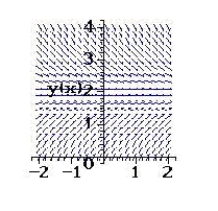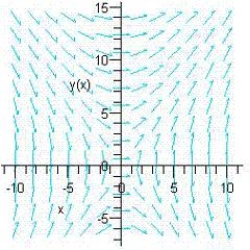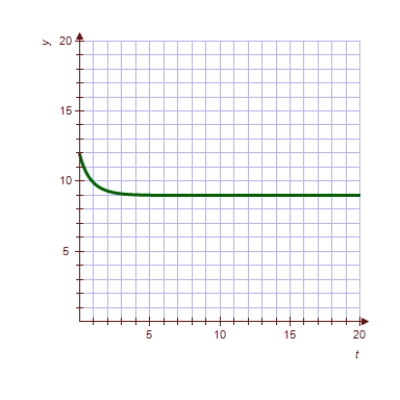A) ![]()
B) ![]()
C) ![]()
D) ![]()
F) All of the above
Correct Answer

verified
Correct Answer
verified
Multiple Choice
Solve the differential equation  .
.
A) ![]()
B) ![]()
C) ![]()
D) ![]()
E) ![]()
G) All of the above
Correct Answer

verified
Correct Answer
verified
Multiple Choice
The logistic function  models the growth of a population.Identify the value of k.
models the growth of a population.Identify the value of k.
A) 3.5
B) 4
C) 2
D) 10
E) 3
G) C) and D)
Correct Answer

verified
Correct Answer
verified
Multiple Choice
Consider the differential equation  ,for which the solution is g(x) . Let y(x) be the particular solution that contains (0,1) .Using Euler's Method with step size
,for which the solution is g(x) . Let y(x) be the particular solution that contains (0,1) .Using Euler's Method with step size  ,what is the estimate for
,what is the estimate for  ?
?
A) 4
B) 3.5
C) 3
D) 4.5
F) None of the above
Correct Answer

verified
Correct Answer
verified
Multiple Choice
Use integration to find a general solution of the differential equation. 
A) ![]()
B) ![]()
C) ![]()
D) ![]()
E) ![]()
G) B) and D)
Correct Answer

verified
Correct Answer
verified
Multiple Choice
Find the particular solution of the differential equation  that satisfies the initial condition
that satisfies the initial condition  when
when  ,where
,where  is the general solution.
is the general solution.
A) ![]()
B) ![]()
C) ![]()
D) ![]()
E) ![]()
G) C) and D)
Correct Answer

verified
Correct Answer
verified
Multiple Choice
A calf that weighs 60 pounds at birth gains weight at the rate  where w is weight in pounds and t is time in years.If the animal is sold when its weight reaches 650 pounds,find the time of sale using the model
where w is weight in pounds and t is time in years.If the animal is sold when its weight reaches 650 pounds,find the time of sale using the model  .Round your answer to two decimal places.
.Round your answer to two decimal places.
A) 7.31 years
B) 2.65 years
C) 1.07 years
D) 0.72 year
E) 0.29 year
G) C) and D)
Correct Answer

verified
Correct Answer
verified
Essay
Solve the differential equation in  to find f(x)in terms of x only.
to find f(x)in terms of x only.
Correct Answer

verified
Rewrite 
Separatin...View Answer
Show Answer
Correct Answer
verified
Separatin...
View Answer
Multiple Choice
Sketch the slope field for the differential equation  and use the slope field to sketch the solution that passes through the point
and use the slope field to sketch the solution that passes through the point  .
.
A) ![]()
B) ![]()
C) ![]()
D) ![]()
E) ![]()
G) All of the above
Correct Answer

verified
Correct Answer
verified
Multiple Choice
The half-life of the carbon isotope C-14 is approximately 5,715 years.If the amount left after 3,000 years is 1.8 g,what is the amount after 6,000 years? Round your answer to three decimal places.
A) 1.251 g
B) 1.043 g
C) 1.800 g
D) 0.604 g
E) 2.502 g
G) A) and B)
Correct Answer

verified
A
Correct Answer
verified
Multiple Choice
Sketch a few solutions of the differential equation on the slope field and then find the general solution analytically. 

A) ![]()
B) ![]()
C) ![]()
D) ![]()
E) ![]()
G) B) and E)
Correct Answer

verified
Correct Answer
verified
Multiple Choice
A container of hot liquid is placed in a freezer that is kept at a constant temperature of  .The initial temperature of the liquid is
.The initial temperature of the liquid is  .After 5 minutes,the liquid's temperature is
.After 5 minutes,the liquid's temperature is  .How much longer will it take for its temperature to decrease to
.How much longer will it take for its temperature to decrease to  ? Round your answer to two decimal places.
? Round your answer to two decimal places.
A) 5.29 minutes
B) 7.94 minutes
C) 8.82 minutes
D) 3.53 minutes
E) 9.70 minutes
G) A) and E)
Correct Answer

verified
Correct Answer
verified
Multiple Choice
The logistic function  models the growth of a population.Determine when the population reaches one-half of the maximum carrying capacity.Round your answer to three decimal places.
models the growth of a population.Determine when the population reaches one-half of the maximum carrying capacity.Round your answer to three decimal places.
A) 0.549
B) 3.333
C) 1.151
D) 5.000
E) 1.000
G) A) and C)
Correct Answer

verified
A
Correct Answer
verified
Multiple Choice
Each of the following graphs is from a logistic function  .Which one has the smallest value of b?
.Which one has the smallest value of b?
A) ![]()
B) ![]()
C) ![]()
D) ![]()
E) ![]()
G) A) and E)
Correct Answer

verified
E
Correct Answer
verified
Multiple Choice
Find the function  passing through the point
passing through the point  with the first derivative
with the first derivative  .
.
A) ![]()
B) ![]()
C) ![]()
D) ![]()
E) ![]()
G) A) and C)
Correct Answer

verified
Correct Answer
verified
Multiple Choice
Find the orthogonal trajectories of the family  .
.
A) ![]()
B) ![]()
C) ![]()
D) ![]()
E) ![]()
G) A) and B)
Correct Answer

verified
Correct Answer
verified
Multiple Choice
Use the differential equation  and its slope field to find the slope at the point
and its slope field to find the slope at the point  .
. 
A) -32
B) -1
C) -8
D) -64
E) 16
G) None of the above
Correct Answer

verified
Correct Answer
verified
Multiple Choice
Find the orthogonal trajectories of the family  .
.
A) ![]()
B) ![]()
C) ![]()
D) ![]()
E) ![]()
G) A) and B)
Correct Answer

verified
Correct Answer
verified
Multiple Choice
Consider the differential equation  ,for which the solution is
,for which the solution is  .Let
.Let  . The particular solution is
. The particular solution is
A) ![]()
B) ![]()
C) ![]()
D) ![]()
F) None of the above
Correct Answer

verified
Correct Answer
verified
Multiple Choice
Match the logistic differential equation and initial condition with the graph of its solution shown below. 
A) ![]()
B) ![]()
C) ![]()
D) ![]()
E) ![]()
G) B) and D)
Correct Answer

verified
Correct Answer
verified
Showing 1 - 20 of 88
Related Exams